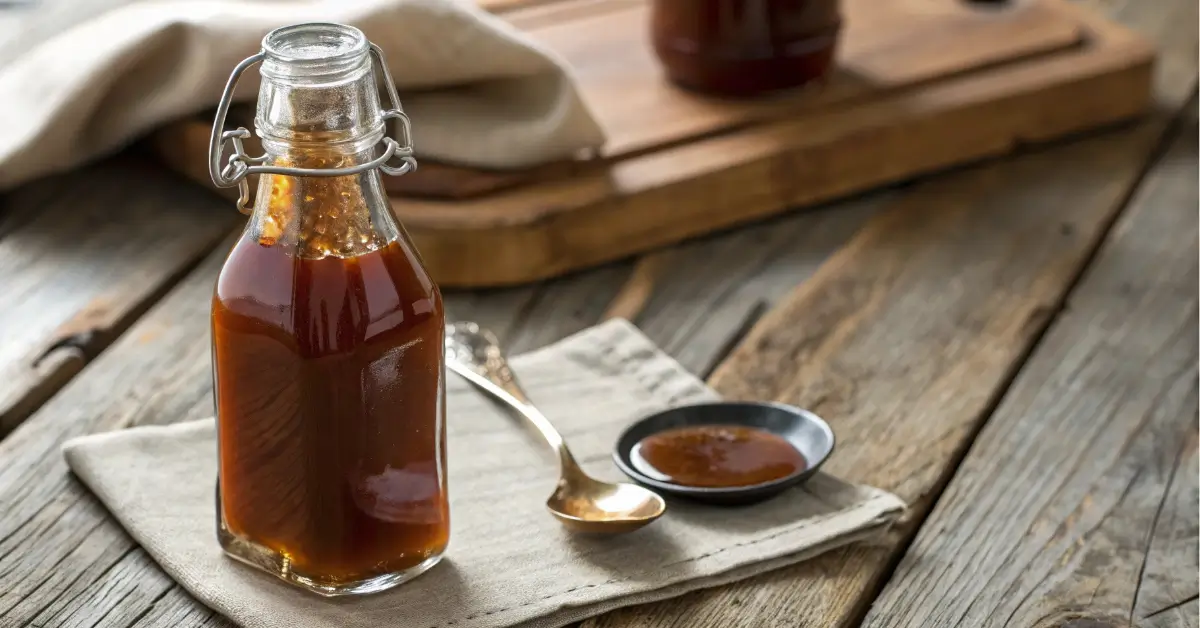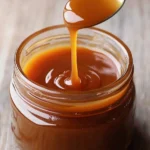Sugar free caramel syrup is becoming a must-have for health-conscious home cooks, coffee lovers, and anyone looking to cut down on added sugars without sacrificing flavor. Whether you’re managing diabetes, counting macros, or following a keto lifestyle, this delicious syrup offers a guilt-free way to enjoy your favorite caramel treats. In this guide, we’ll explore everything from the best brands and health benefits to homemade recipes and Starbucks comparisons. You’ll also learn how to use it creatively in drinks and desserts.
Looking for inspiration? Try our protein popcorn recipe that pairs surprisingly well with a drizzle of sugar free caramel syrup.
Jumo to:
What Is Sugar Free Caramel Syrup?
Understanding Sugar Substitutes Used in Caramel Syrup
To put it simply, sugar free caramel syrup mimics traditional caramel flavor without relying on real sugar. Instead, manufacturers use low or zero-calorie sweeteners such as erythritol, sucralose, stevia, monk fruit extract, or a combination. These alternatives provide sweetness without impacting blood glucose levels, which makes the syrup suitable for diabetics and those following low-carb or ketogenic diets.
Each sweetener offers a different taste profile and aftertaste. For example:
| Sweetener | Calories | Glycemic Index | Flavor Notes |
|---|---|---|---|
| Erythritol | 0.24/gram | 0 | Cool, clean |
| Sucralose | 0 | 0 | Very sweet, artificial |
| Stevia | 0 | 0 | Herbal, slightly bitter |
| Monk Fruit | 0 | 0 | Mild, fruit-like sweetness |
Some brands also add thickeners like xanthan gum or vegetable glycerin to replicate the syrupy consistency of traditional caramel.
How Sugar-Free Varieties Compare to Traditional Syrups
In traditional caramel syrup, sugar is the main ingredient and source of viscosity and flavor. But with sugar free caramel syrup, the game changes. Instead of melting sugar, recipes or brands use caramel flavoring agents, natural color, and safe preservatives to create the familiar taste while keeping it calorie-friendly.
| Criteria | Traditional Caramel Syrup | Sugar Free Caramel Syrup |
|---|---|---|
| Calories | 50–100 per serving | 0–15 per serving |
| Sugar Content | 10–20g per tbsp | 0g |
| Sweeteners Used | Cane Sugar, Corn Syrup | Erythritol, Sucralose, etc |
| Suitable for Diabetics | No | Yes |
| Keto-Friendly | No | Yes |
Because sugar alcohols and natural substitutes do not crystallize or caramelize the same way sugar does, the end product may taste slightly different. However, many users find the syrup just as satisfying—especially in coffee, oatmeal, or yogurt.
Don’t miss our DIY keto vanilla protein powder if you’re planning to build a complete low-carb pantry.
Health Benefits and Nutritional Facts
Is Sugar-Free Caramel Syrup Actually Healthy?
Many people wonder if sugar free caramel syrup is just a marketing trend or if it offers real health benefits. The answer depends on the ingredients and how you use it. The main health advantage of sugar-free syrup is its absence of refined sugars, which can help:
- Stabilize blood glucose levels
- Reduce calorie intake
- Lower risks of insulin resistance
- Support weight loss goals
Most commercially available sugar-free caramel syrups are labeled as keto, diabetic-friendly, or low-calorie, making them a convenient alternative for those watching their sugar intake. Unlike traditional syrup, which can spike your blood sugar, sugar-free versions are crafted using non-nutritive sweeteners that pass through the body without raising insulin.
Still, not all sugar-free syrups are created equal. Some include artificial additives, preservatives, and questionable thickeners. It’s best to look for clean-label options with minimal ingredients and zero hidden sugars.
Check out our guide on keto pies with apple flavor for a recipe that pairs beautifully with a sugar-free caramel drizzle.
Caloric Breakdown and Macronutrient Content
One of the most appealing features of sugar free caramel syrup is its low calorie count. While traditional caramel syrups can contain 50–100 calories per tablespoon, most sugar-free versions range from 0 to 15 calories depending on the brand and added ingredients.
Here’s a typical nutrition label for a store-bought sugar-free caramel syrup (per 1 tablespoon serving):
| Nutrient | Amount |
|---|---|
| Calories | 0–15 |
| Total Fat | 0g |
| Total Carbohydrates | 0–1g |
| Sugars | 0g |
| Sugar Alcohols | 2–5g |
| Protein | 0g |
While sugar alcohols like erythritol contribute to sweetness, they are not counted as net carbs on keto diets due to their minimal impact on blood sugar.
Let’s not forget: moderation matters. Excessive consumption of sugar alcohols can cause digestive discomfort. Start small and see how your body reacts, especially if you’re new to low-carb or artificial sweeteners.
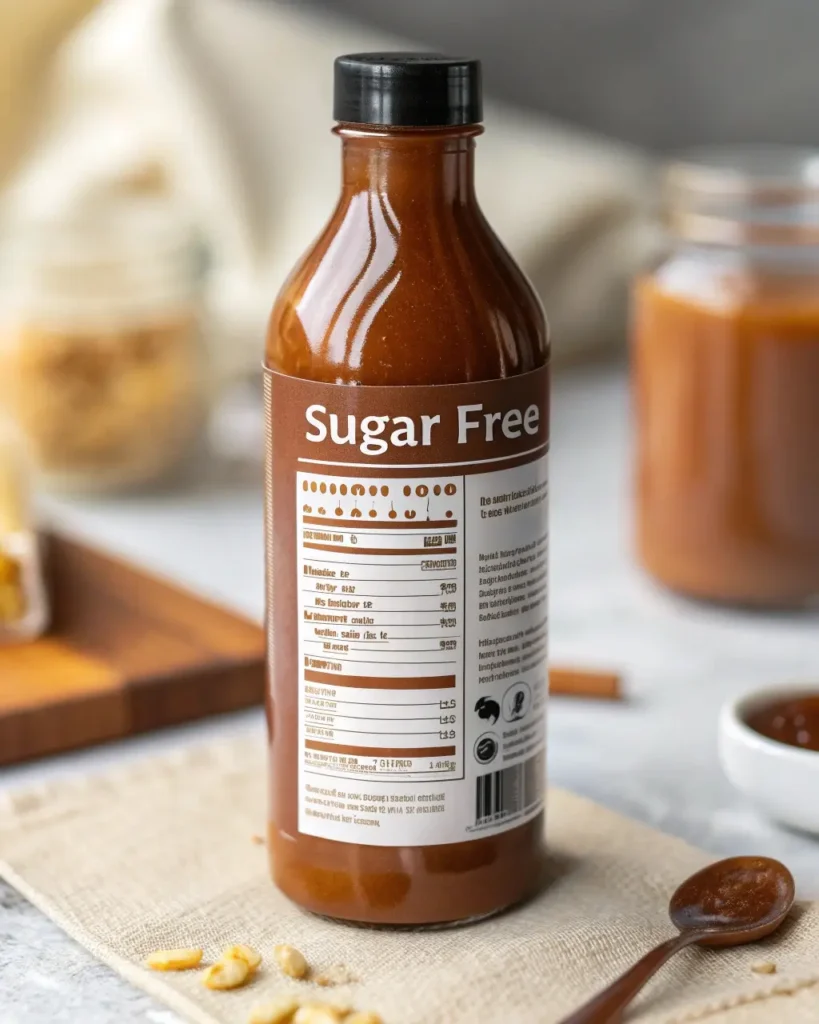
Discover great ideas like our coconut clusters—a crunchy, clean snack that tastes heavenly with a caramel swirl.
Best Brands of Sugar Free Caramel Syrup in 2025
Top Rated Store-Bought Options (Torani, Jordan’s Skinny Syrups, and More)
Choosing the best sugar free caramel syrup can feel overwhelming with so many brands claiming to be the healthiest, tastiest, or most keto-friendly. After analyzing customer reviews, ingredient lists, and taste tests, here are the top contenders dominating 2025:
- Jordan’s Skinny Syrups – Sugar-Free Caramel
- Sweetened with sucralose
- Zero calories, zero sugar
- Great for coffee, cocktails, and oatmeal
- Affordable and widely available
- Torani Sugar Free Caramel Syrup
- A Starbucks-style classic
- Sweetened with sucralose
- Has a strong caramel aroma and buttery finish
- Best for lattes and frappes
- Monin Sugar Free Caramel Syrup
- Sweetened with erythritol and stevia
- More natural flavor profile
- Slightly higher in price but more gourmet
- No artificial colors or preservatives
- Lakanto Sugar-Free Caramel Syrup
- Monk fruit + erythritol blend
- Thick, sauce-like consistency
- Keto-approved and diabetic-friendly
- Ideal for drizzling on pancakes or ice cream
Here’s a quick comparison chart:
| Brand | Sweetener | Calories | Texture | Ideal For |
|---|---|---|---|---|
| Jordan’s Skinny | Sucralose | 0 | Thin | Coffee, cold drinks |
| Torani | Sucralose | 0 | Medium | Lattes, frappes |
| Monin | Stevia + Erythritol | 0 | Thin | Gourmet desserts |
| Lakanto | Monk fruit + Erythritol | 15 | Thick | Keto treats, toppings |
Want a store-bought dessert to pair it with? Check out our Swiss chocolate chalet cake for a dreamy sugar-free experience.
Comparative Chart: Taste, Ingredients, and Pricing
When it comes to taste, not all sugar-free syrups are created equal. Some have an overly artificial aftertaste, while others strike a perfect balance. Here’s what you should evaluate:
- Sweetness intensity: Some syrups are very sweet due to concentrated sucralose.
- Aftertaste: Erythritol tends to leave a cooling sensation; stevia might taste herbal.
- Ingredients: Look for options with natural flavors and no preservatives.
- Price per bottle: Most range from $4 to $9 depending on the brand and bottle size.
| Brand | Aftertaste Rating | Ingredient Transparency | Price (USD) |
|---|---|---|---|
| Torani | Moderate | Medium | $6.99 |
| Jordan’s | Mild | Low | $4.99 |
| Monin | Natural finish | High | $8.49 |
| Lakanto | Clean & bold | Very High | $7.99 |
Don’t miss our protein cookie dough recipe—it’s even better with a touch of Lakanto’s sugar free caramel syrup mixed in!
Sugar Free Caramel Syrup and Diabetes
Can Diabetics Safely Enjoy Sugar Free Syrups?
The short answer is yes—sugar free caramel syrup can be a safe and tasty option for people with diabetes. Because it contains no real sugar and is typically made with non-nutritive sweeteners like sucralose, erythritol, stevia, or monk fruit, it doesn’t cause the same rapid rise in blood glucose levels as traditional syrups.
According to the American Diabetes Association, sugar substitutes like the ones found in sugar-free syrups are generally recognized as safe for diabetic consumption. But here’s the kicker—not all brands are created equal. Some may include fillers or additives that subtly raise insulin levels. Always check the ingredient list for:
- Maltodextrin (can spike blood sugar)
- Dextrose (sugar-based additive)
- Hidden carbs or modified starches
For best results, choose brands labeled keto-friendly, low glycemic, or zero glycemic impact.
Don’t miss our easy chicken thighs hominy casserole, which fits beautifully into a diabetic-friendly meal plan—especially when you’re looking for sweet-savory balance.
Impact on Blood Sugar Levels and Insulin Response
Even though sugar free caramel syrup avoids traditional sugar, you should still monitor how it affects your personal blood glucose. Here’s why:
- Sucralose typically has no glycemic impact, but when heated, it may slightly affect insulin in sensitive individuals.
- Erythritol is widely praised for its non-impact on blood glucose. It’s absorbed in the small intestine and excreted unchanged.
- Stevia and monk fruit are natural and have zero glycemic indexes, making them ideal choices.
| Sweetener | Glycemic Index | Safe for Diabetics? | Notes |
|---|---|---|---|
| Sucralose | 0 | Yes | May affect insulin when heated |
| Erythritol | 0 | Yes | Safe in moderate amounts |
| Stevia | 0 | Yes | Natural, herbal aftertaste |
| Monk Fruit | 0 | Yes | Great for baking and syrups |
For those using insulin or managing Type 2 diabetes, test your blood sugar levels 1 to 2 hours after consuming sugar-free syrup for a personalized response.
Looking for a tasty treat that doesn’t disrupt your diet? Try our candied cashews made with sugar-free sweeteners—they’re a crunchy, caramel-kissed snack with zero sugar guilt.
How to Make Homemade Sugar Free Caramel Syrup
Step-by-Step DIY Recipe (Keto and Vegan Options)
Craving that sweet, buttery caramel taste without the sugar? Making your own sugar free caramel syrup at home is easier than you might think—and it gives you total control over the ingredients. This recipe is low-carb, keto-approved, and even suitable for vegan diets.
Ingredients:
- 1 cup granulated erythritol or monk fruit blend
- 1/2 cup filtered water
- 1/4 tsp xanthan gum (optional for thickness)
- 1 tbsp unsalted vegan butter or coconut oil
- 1/2 tsp vanilla extract
- Pinch of sea salt
Instructions:
- Melt the sweetener
In a non-stick saucepan over medium heat, melt the erythritol until it begins to turn golden brown. Stir constantly to avoid burning. - Add liquids carefully
Slowly add the water, stirring quickly as the mixture will bubble. Then whisk in the butter or oil, and continue to stir until fully combined. - Thicken (optional)
Sprinkle in the xanthan gum if you want a thicker, syrup-like consistency. Whisk vigorously to prevent clumps. - Flavor it up
Remove from heat and stir in vanilla extract and sea salt. Let it cool for 10 minutes before transferring to a glass jar. - Store and use
Keep it refrigerated in a sealed container for up to 2 weeks. Gently reheat before using to loosen the texture.
Want to see this syrup in action? Check out our banana nut bread Starbucks-style for the perfect base to drizzle this homemade caramel goodness.
Tips for Thickening Without Sugar or Corn Syrup
Traditional syrups rely on corn syrup or cane sugar for viscosity, but when you’re creating a sugar free caramel syrup, you need other tricks. Here are the best thickeners that are low-carb and keto-approved:
- Xanthan Gum – Just 1/8 to 1/4 teaspoon thickens the syrup without adding carbs.
- Guar Gum – A natural plant-based alternative, but use sparingly to avoid clumping.
- Gelatin or Agar Agar – Useful for recipes needing a thicker, almost sauce-like texture.
Also, don’t forget: letting your syrup cool completely will help it thicken naturally, especially when stored in the fridge.
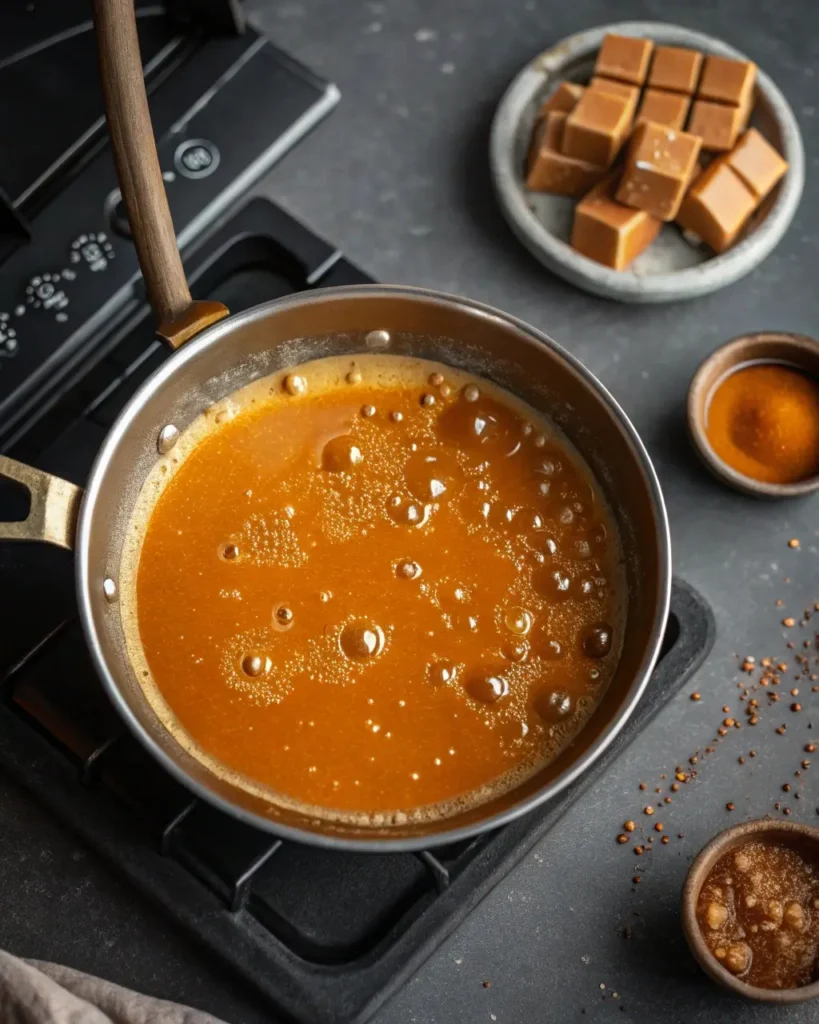
Discover more DIY sweetness in our homemade almond flour crepes—a match made in sugar-free heaven when paired with your caramel drizzle.
How to Use Sugar Free Caramel Syrup in Recipes
Coffee, Tea & Lattes: Flavoring Beverages Without Sugar
One of the most popular ways to enjoy sugar free caramel syrup is in your daily coffee routine. It delivers that warm, buttery sweetness without the sugar spike or guilt. Whether you’re sipping on a hot latte or a cold brew, here’s how to incorporate it seamlessly:
- Caramel Iced Coffee: Add 1–2 tbsp of syrup to brewed coffee over ice with a splash of almond milk.
- Skinny Caramel Latte: Steam milk (or dairy-free alternative), mix in 1 tbsp syrup, and top with espresso.
- Sugar-Free Dirty Chai: Combine chai tea with espresso and 1 tsp sugar free caramel syrup for a spicy-sweet twist.
Pro tip: Use a frother to mix the syrup evenly through hot drinks—no settling at the bottom!
Looking for more low-sugar drink inspiration? Don’t miss our kefir sheet cake recipe card, which makes a lovely pairing with a caramel chai latte.
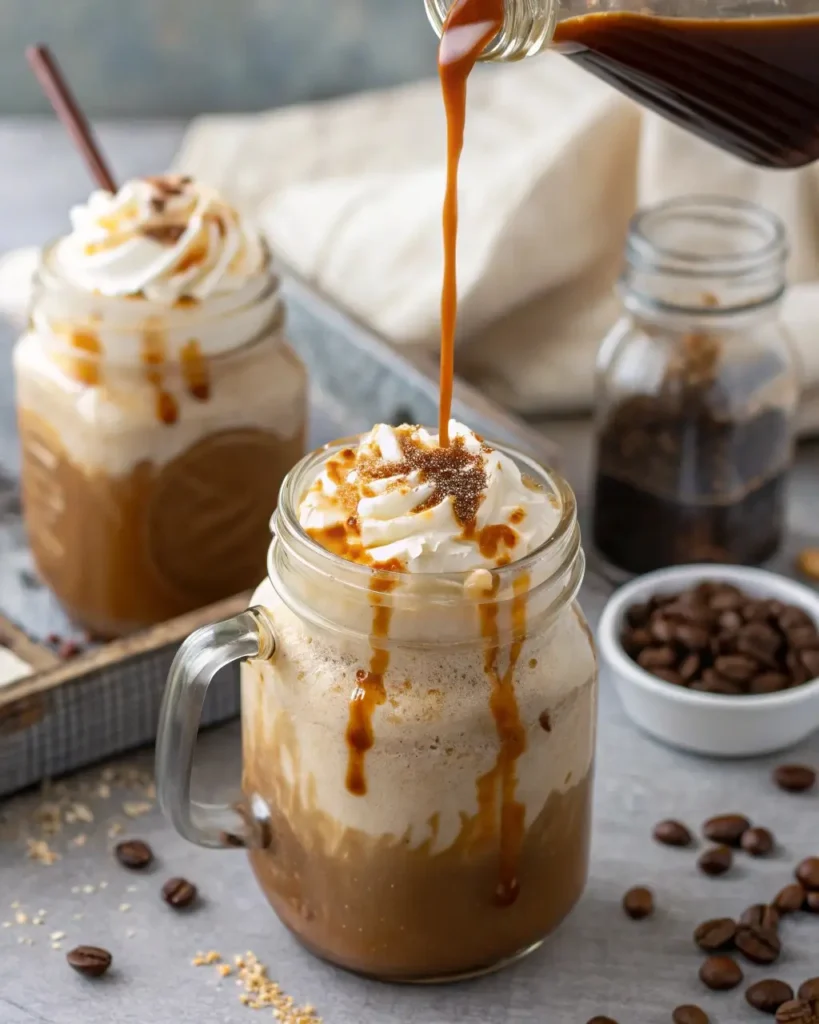
Baking and Dessert Ideas: Healthy Twists on Classics
Sugar free caramel syrup isn’t just for coffee lovers—it shines in desserts too. Because it maintains flavor without added sugar, it’s a lifesaver for low-carb baking and guilt-free treats.
Here are some delicious ways to use it:
- Drizzle over pancakes, waffles, or French toast made with almond or coconut flour.
- Swirl into cheesecake batter or as a topping for keto mini cheesecakes.
- Layer into parfaits with sugar-free yogurt and nuts for added depth.
- Mix into protein shake bowls to create dessert-like smoothies without sugar overload.
- Use as filling for chocolate caramel fat bombs on a ketogenic diet.
| Recipe Idea | Sugar Free Caramel Use |
|---|---|
| Low-carb brownies | Swirl in before baking |
| Protein mug cake | Top after microwaving |
| Sugar-free banana pudding | Layer or drizzle |
| Keto donuts | Glaze with warm syrup |
Try pairing it with our 3-ingredient banana bread for a naturally sweetened breakfast treat.
The syrup’s texture also makes it ideal for finishing a dish right before serving. Whether you’re plating a dessert or prepping for a food photo, it adds that luscious visual appeal—without the sugar bomb.
Starbucks and Sugar Free Caramel Syrup
Which Syrup Does Starbucks Use for Sugar-Free Caramel?
Many fans of Starbucks wonder about the ingredients behind their lighter drink options—especially the sugar free caramel syrup that used to be a staple on their menu. Historically, Starbucks used a sugar-free caramel syrup sweetened with sucralose (Splenda). This syrup had zero calories and zero sugar, making it a go-to for keto, diabetic, and calorie-conscious customers.
However, Starbucks discontinued their sugar-free caramel syrup in U.S. locations several years ago. The official reason? Low demand and issues with the flavor profile. As of now, only sugar-free vanilla remains a standard offering. If you want caramel flavor with no added sugar, you’ll need to DIY or bring your own!
Here’s how to hack it:
- Order an Americano or cold brew with sugar-free vanilla syrup and ask for a light caramel drizzle (contains sugar).
- Bring a mini bottle of your favorite sugar free caramel syrup and add it after ordering.
- Customize your drink with steamed almond or oat milk and a sprinkle of cinnamon for richness.
Discover great ideas like our protein rice krispies to enjoy alongside your homemade Starbucks-style caramel latte.
How Their Syrup Compares to DIY or Store-Bought Versions
While the discontinued Starbucks sugar free caramel syrup had a devoted following, taste testers often noted a mild artificial aftertaste. Many now prefer alternatives like:
- Jordan’s Skinny Syrups: Stronger caramel notes, zero calories.
- Lakanto Caramel Syrup: Rich and buttery with monk fruit sweetness.
- DIY versions: Customizable and free from preservatives or fillers.
Let’s compare them briefly:
| Version | Sweetener | Flavor Profile | Pros | Cons |
|---|---|---|---|---|
| Starbucks (past) | Sucralose | Light, mild | Convenient at cafes | Discontinued, artificial |
| Jordan’s Skinny | Sucralose | Strong, buttery | Inexpensive, zero-calorie | Slight artificial taste |
| Lakanto | Monk Fruit | Rich, smooth | Natural, keto-friendly | Pricier |
| Homemade | Erythritol/etc. | Customizable | Clean, no additives | Requires prep & storage |
So while Starbucks might’ve dropped the ball on this one, you’ve got better options now. Whether you’re looking for natural ingredients, rich taste, or the perfect coffee syrup, sugar free caramel syrup brands today deliver far more versatility and health-conscious features.
Caramel Syrup vs. Caramel Sauce
Key Differences in Ingredients, Texture & Use
Although the names sound similar, caramel syrup and caramel sauce aren’t interchangeable—especially when we’re talking sugar free caramel syrup. Each has unique ingredients, consistency, and culinary applications.
Caramel Syrup
- Made primarily with water, sweetener, flavoring, and sometimes thickeners.
- Thin and pourable consistency
- Used to flavor coffee, cold drinks, cocktails, oatmeal, and pancakes.
- Often zero-calorie and low-carb
Caramel Sauce
- Made with butter, cream, and a caramelized sweetener
- Thick, gooey, and rich
- Ideal as a topping for desserts, ice cream, and baked goods
- Contains more fat and often more calories—even in sugar-free versions
| Feature | Caramel Syrup | Caramel Sauce |
|---|---|---|
| Thickness | Thin, watery | Thick, creamy |
| Best For | Drinks, flavoring | Toppings, baking |
| Calories (sugar-free) | 0–15 per tbsp | 20–50 per tbsp |
| Common Ingredients | Sweetener, water, extract | Butter, cream, sweetener |
| Keto-Friendly? | Yes | Yes (if made with low-carb cream) |
Because sugar free caramel syrup skips the butter and cream, it’s far easier to keep it ultra-low in calories and carbs. This makes it perfect for everyday use—especially when you want to enjoy that buttery caramel taste without weighing down your drinks or desserts.
Don’t miss our ghost protein balls recipe—they’re ideal for drizzling with sugar-free caramel sauce or syrup, depending on the texture you want!
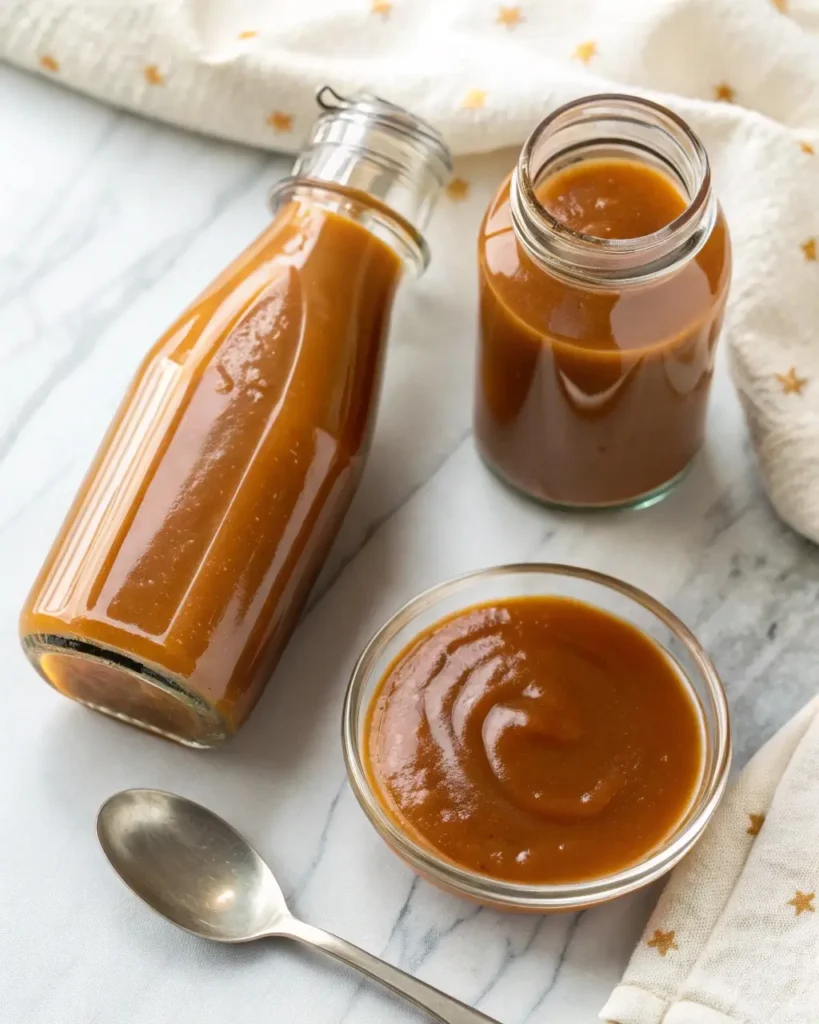
When to Choose Syrup vs. Sauce for Recipes
So when should you reach for syrup over sauce—or vice versa?
Choose sugar free caramel syrup if:
- You’re mixing it into coffee or tea
- You want a low-calorie drizzle on your morning oatmeal
- You’re baking and need a flavor swirl rather than a thick topping
- You want it to blend smoothly into shakes or smoothies
Choose sugar free caramel sauce if:
- You’re topping ice cream, cheesecake, or brownies
- You need a luxurious texture to wow your guests
- You’re filling keto fat bombs or layering in trifles
Each has a place in your kitchen, but if you’re looking for daily versatility, syrup is king.
Where to Buy Sugar Free Caramel Syrup
Best Online Shops and Grocery Chains
If you’re ready to stock your pantry with sugar free caramel syrup, you’re in luck—it’s more accessible than ever. From online marketplaces to local grocery aisles, these are the best places to find your perfect bottle.
Top Online Retailers
- Amazon – Huge selection, fast shipping, subscription discounts. Brands: Torani, Jordan’s Skinny, Lakanto, Monin.
- Netrition – Specializes in low-carb and keto-friendly products. Ideal for sugar-free lifestyle followers.
- Thrive Market – Great for organic, gluten-free, and natural products. You’ll often find exclusive sugar-free options.
- Lakanto.com – The official store offers deals, bundles, and direct shipping for their caramel syrup.
Grocery Chains to Check
- Whole Foods – Carries Monin and organic syrup options.
- Walmart – Offers Jordan’s Skinny Syrups at great prices.
- Sprouts & Trader Joe’s – May stock seasonal or house-brand sugar-free syrups.
- Target – Often carries Torani’s sugar-free line in-store and online.
Don’t miss our chocolate crepe cake—perfect for layering with your syrup haul from any of these stores.
How to Read Labels and Avoid Hidden Sugars
Not all sugar free caramel syrup bottles are as innocent as they look. Some brands sneak in hidden sugars or use sweeteners that could spike your blood sugar. Here’s how to read between the lines:
What to Look For:
- Sweeteners: Choose erythritol, monk fruit, stevia, or sucralose
- Zero Calories: Ideally under 15 calories per serving
- No Maltodextrin or Corn Syrup Solids
- Glycemic Impact: Look for terms like “low glycemic” or “keto-certified”
Avoid These Ingredients:
- Maltitol – Common in sugar-free products but has a high glycemic index
- Hidden carbs – If net carbs aren’t listed, check fiber and sugar alcohols
- Artificial flavors & colors – Opt for clean labels when possible
| Label Clue | What It Means |
|---|---|
| “No Sugar Added” | Could still contain natural sugars |
| “Low Glycemic” | Safe for diabetics |
| “Keto-Friendly” | Typically low in net carbs |
| “With Sucralose” | Zero calorie, but artificial |
Reading labels doesn’t have to be intimidating. Just stick to clean ingredients, zero sugar, and safe sweeteners—and you’ll be pouring sugar free caramel syrup with confidence.
Frequently asked questions
What sugar free caramel syrup does Starbucks use?
Starbucks used to offer a sucralose-based sugar-free caramel syrup, but it was discontinued. Now, only sugar-free vanilla is typically available.
Can diabetics have sugar free syrups?
Yes. Sugar-free syrups made with non-nutritive sweeteners like erythritol, stevia, or sucralose are generally safe for diabetics, though moderation is still key.
How many calories are in sugar free caramel syrup?
Most sugar free caramel syrups contain between 0 and 15 calories per tablespoon, depending on the brand and ingredients.
Is Torani sugar free caramel good?
Yes, it’s one of the most popular options for coffee and cold drinks. It’s sweetened with sucralose and has a buttery flavor profile.
Does Starbucks sugar free syrup spike blood sugar?
Starbucks’ sugar-free syrups are typically made with sucralose, which doesn’t raise blood sugar in most people. However, always monitor your own response.
What is the difference between caramel syrup and sauce at Starbucks?
Syrup is thin and used to flavor drinks; sauce is thicker and used as a topping. The syrup is mixed into the beverage, while the sauce adds richness.
Conclusion: Why Sugar Free Caramel Syrup Belongs in Your Pantry
Whether you’re aiming to manage your blood sugar, stay in ketosis, or simply enjoy guilt-free indulgence, sugar free caramel syrup is your go-to flavor booster. With an array of brands, sweeteners, and uses—from lattes to low-carb desserts—you can satisfy your caramel cravings without breaking your health goals. Just remember to choose high-quality ingredients, monitor your sweetener intake, and get creative in the kitchen.
Check out our almond flour crepes to pair with your homemade or store-bought sugar-free caramel syrup—you’ll be hooked from the first bite!
PrintSugar Free Caramel Syrup
A rich and creamy sugar-free caramel syrup that’s perfect for coffee, desserts, or pancakes. This easy-to-make syrup uses simple ingredients for a guilt-free indulgence.
- Prep Time: 5 minutes
- Cook Time: 5 minutes
- Total Time: 10 minutes
- Yield: 8 servings
- Category: Sauce/Topping
- Method: Stovetop
- Cuisine: American
- Diet: Diabetic
Ingredients
- 2 tablespoons unsalted butter
- ½ cup heavy cream
- 3 tablespoons sugar-free caramel syrup (store-bought or homemade)
- 1 tablespoon erythritol or preferred sugar-free sweetener
Instructions
- Melt the butter in a small saucepan over medium heat.
- Slowly add the heavy cream while stirring continuously.
- Incorporate the sugar-free caramel syrup and erythritol.
- Let the mixture simmer for 3–5 minutes, stirring until thickened.
- Remove from heat, cool slightly, and serve as a topping or drizzle.
Notes
- For a thicker consistency, simmer the syrup a few extra minutes.
- Store in an airtight container in the refrigerator for up to one week.
- This recipe is keto-friendly and low-carb.

